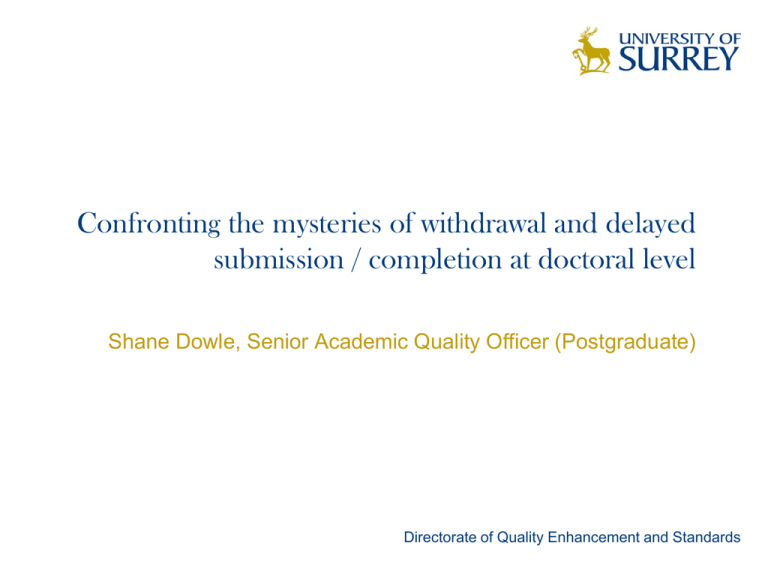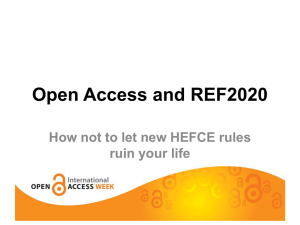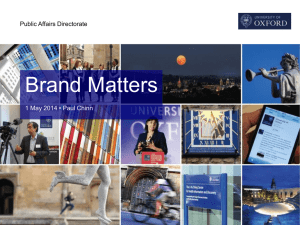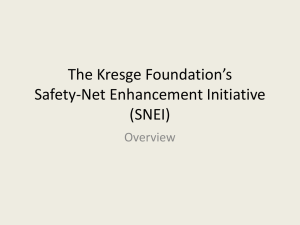- Society for Research into Higher Education
advertisement

Confronting the mysteries of withdrawal and delayed submission / completion at doctoral level Shane Dowle, Senior Academic Quality Officer (Postgraduate) Directorate of Quality Enhancement and Standards Submission and completion rates – why are they important? • Financial Risks • REF • Research Council Awards (DTCs and Research Funding) • Costs of prolonged registration • Reputational Risks • HEFCE Projections • International league tables • PRES • The most vulnerable– the doctoral researcher Directorate of Quality Enhancement and Standards Whose definition? • Different measures: • • • • • • • REF (Headcount – HESA completion date) RCUK Bids (4 year submission rates) RCUK Completion survey (Pass/minor corrections date) HEFCE Projections (7 and 20 years) Overseas funders (three year submissions) Institutional regulations (PhD vs Practitioner Doctorates) Part-timers? • How should we measure ourselves? Directorate of Quality Enhancement and Standards What do we know about withdrawal and completion in the UK? • Not a lot… • HEFCE: 09/10 starters - 70.9% projected to complete in 7 years 10/11 starters - 72.9% projected to complete in 7 years • HEFCE (2005): Younger, funded, overseas, natural sciences most successful • Park (2005): Older, UK-domiciled, part-time, humanities and social sciences most likely non-completers • Time to take a closer look at this? Directorate of Quality Enhancement and Standards What do we know about completion and withdrawal outside of the UK? • A lot more… • Numerous studies from US and Australia BUT they each relate to one institution • Discrepancies between institutions and departments within an institution – De Valero (2001) • No easy answer “factors related to TTD [time to doctorate] are intertwined and involve a complex interplay of institutional and personal factors” Wao & Onwuegbuzie (2011) Directorate of Quality Enhancement and Standards Thesis Completion Triangle Jiranek (2010) Directorate of Quality Enhancement and Standards Supervision • Positive factors (de Valero, 2001; Wao & Onwuegbuzie, 2011; Green & Bowden, 2012): • Involved • Nurturing • Supportive • Negative factors (Golde, 2000): • Personality clash • Indifference towards project • No time for doctoral researcher Directorate of Quality Enhancement and Standards Student Qualities and Personal Circumstances • Student characteristics • Age • Gender • Attitudinal factors • Socio-economic factors? • Registration characteristics • Fee status • Funding status • Registration status (FT/PT) • Previous qualifications Directorate of Quality Enhancement and Standards Research Facilities and Resources • Additional support outside of the supervisor team (Jimenez y West, 2010): • ‘Graduate School’ – Focal point for doctoral researchers • Cohort building through workshops, weekend retreats and emotional support • Resources are least important factor in determining success (Green and Bowden, 2012) Directorate of Quality Enhancement and Standards Further discussion • We need to learn more • Which side of the Jiranek’s triangle is most important? • What can we do to identify and prevent “at risk” doctoral researchers from non-completion? • Is a local or institutional approach best? Or both? • What can we do to ensure part-timers are not overlooked? • Do we need a consistent way of measuring the problem? • What role could a central “Graduate School” play? Directorate of Quality Enhancement and Standards Bibliography 1 • de Valero, Y. F., 2001. Departmental factors affecting time-todegree and completion rates of doctoral students at one landgrant research institution. The Journal of Higher Education, 72(3), pp. 341-367. • Golde, C. M., 2000. Should I stay or should I go? Student descriptions of the doctoral attrition process. The Review of Higher Education, 23(2), pp. 199-227. • Green, P. & Bowden, J., 2012. Completion mindsets and contexts in doctoral supervision. Quality Assurance in Education, 20(1), pp. 66-80. • HEFCE, 2005. PhD Research Degrees, Swindon: HEFCE. • HEFCE, 2012. Rates of qualification from postgraduate research degrees: Projected study outcomes of full-time students starting postgraduate research degrees in 2008-9 and 2009-10, Swindon: HEFCE. Directorate of Quality Enhancement and Standards Bibliography 2 • HEFCE, 2013. Rates of qualification from postgraduate research degrees: Projected study outcomes of full-time students starting postgraduate research degrees in 2010-11, Swindon: HEFCE. • Jimenez y West, I. et al., 2010. Exploring effective support practices for doctoral students' degree completion. College Student Journal, 45(2), pp. 310-323. • Jiranek, V., 2010. Potential predictors of timely completion among dissertation research students at an Australian Faculty of Sciences. International Journal of Doctoral Studies, 5(1), pp. 113. • Jump, P., 2013. Times Higher Education. [Online] Available at: http://www.timeshighereducation.co.uk/story.aspx?storyCode=20 06040 [Accessed 1 December 2013]. Directorate of Quality Enhancement and Standards Bibliography 3 • Park, C., 2005. War of attrition: patterns of non-completion amongst postgraduate research students. Higher Education Review, 38(1), pp. 48-53. • Rodwell, J. & Neumann, R., 2008. Predictors of timely doctoral student completions by type of attendance: the utility of a pragmatic approach. Journal of Higher Education Policy and Management, 30(1), pp. 65-76. • van de Schoot, R., Yerkes, M. A., Mouw, J. M. & Sonneveld, H., 2013. What took the so long? Explaining PhD delays among doctoral candidates. PLoS ONE, 8(7), pp. 1-11. • Wakeling, P. & Hampden-Thompson, G., 2013. Transition to higher degrees across the UK: an analysis of national, institutional and individual differences, York: HEA. • Wao, H. O. & Onwuegbuzie, A. J., 2011. A mixed research investigation of factors related to time to doctorate in Education. International Journal of Doctoral Studies, 6(1), pp. 115-133. Directorate of Quality Enhancement and Standards











